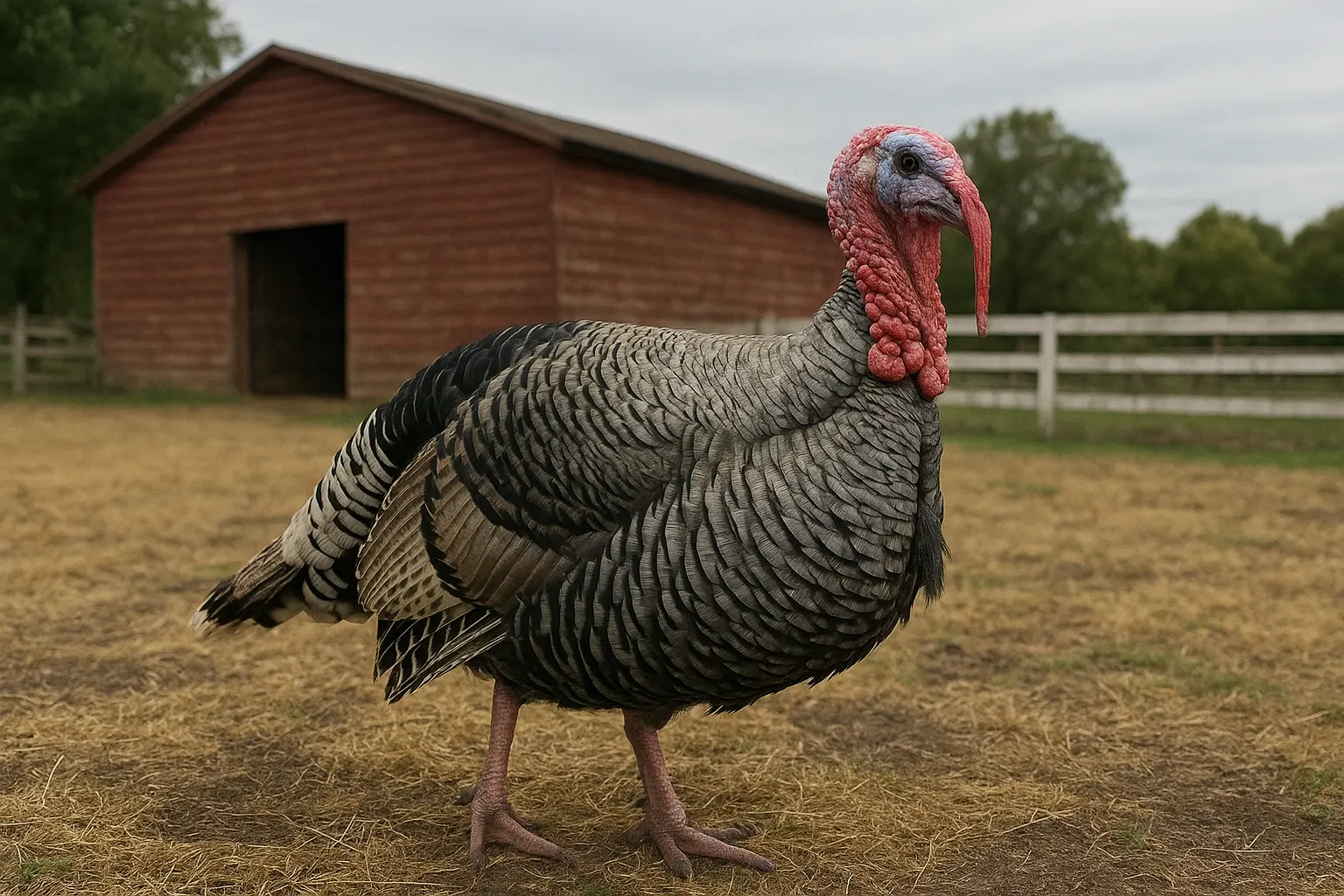
Common Health Conditions in Ducks
Ducks are hardy, adaptable birds and a joy to keep, whether in a backyard pond, smallholding, or larger farm setting. While generally more disease-resistant than chickens, they are not immune to health problems. Early diagnosis, good husbandry practices, and preventive measures can make all the difference in maintaining a healthy flock.
This guide provides detailed information on the most common and rare duck health conditions, including symptoms, causes, treatment options, and prevention strategies.
Bumblefoot
Overview
Bumblefoot (pododermatitis) is a bacterial infection of the foot, usually caused by a cut, scrape, or continuous pressure on the footpad.
Symptoms
- Limping or reluctance to walk
- Swollen, warm footpad
- Dark scab or abscess on the bottom of the foot
Causes
- Rough or hard surfaces
- Excessive weight
- Dirty bedding or standing water
Treatment
- Clean and disinfect the wound
- Apply antibiotic ointment and bandage
- In advanced cases, surgical removal of abscess may be needed
Prevention
- Provide soft, dry bedding
- Avoid sharp surfaces
- Keep living area clean and dry
Respiratory Infections
Overview
Respiratory diseases can be bacterial, viral, or fungal in origin and are more common in cold, damp, or poorly ventilated conditions.
Symptoms
- Sneezing or coughing
- Nasal discharge
- Laboured breathing or wheezing
- Lethargy and loss of appetite
Causes
- Poor ventilation
- Ammonia build-up
- Sudden changes in temperature
- Contaminated water
Treatment
- Supportive care (warmth, hydration, rest)
- Veterinary antibiotics if bacterial
- Isolate sick birds
Prevention
- Ensure dry, draft-free housing with good ventilation
- Change bedding regularly
- Provide clean water daily
Botulism
Overview
Botulism is a life-threatening condition caused by toxins from the bacterium Clostridium botulinum, usually ingested from decaying organic matter.
Symptoms
- Weakness and flaccid paralysis
- Limp neck (limberneck)
- Inability to walk or lift head
- Rapid death if untreated
Causes
- Ingesting contaminated water or feed
- Access to decomposing animal carcasses or vegetation
Treatment
- Administer antitoxin if available
- Supportive care: fluids, warmth
- Immediate vet assistance required
Prevention
- Remove decaying organic material and dead animals from the environment
- Prevent access to stagnant water
Wet Feather
Overview
Wet feather is a condition where a duck’s waterproofing fails, leaving feathers waterlogged and the bird cold and uncomfortable.
Symptoms
- Feathers appear dull, clumped, or soggy
- Bird avoids water or struggles to float
- Shivering or weight loss
Causes
- Over-preening or stress
- Oil gland dysfunction
- Poor water quality or lack of clean bathing water
Treatment
- Dry the duck thoroughly
- Allow access to clean water for bathing
- Feed high-quality diet with added omega-3 oils
- In severe cases, consult a vet
Prevention
- Provide clean, deep water for bathing daily
- Reduce stress and overcrowding
- Offer high-quality feed
Niacin Deficiency
Overview
Niacin (vitamin B3) is crucial for duckling development, particularly for healthy leg and joint formation.
Symptoms
- Weak legs or inability to stand
- Bowed legs
- Reluctance to walk or constant sitting
- Lameness or “splayed leg” in ducklings
Causes
- Inadequate diet (especially chick starter feed, which lacks niacin)
- Poor absorption in some genetic lines
Treatment
- Supplement with brewer’s yeast or niacin tablets (no-flush, plain form)
- Adjust feed to include appropriate duck rations
Prevention
- Use waterfowl-specific or niacin-fortified feed
- Add brewer’s yeast to chick starter if using for ducklings
Avian Influenza
Overview
Avian flu is a notifiable viral disease with severe impacts on both domestic and wild birds.
Symptoms
- Sudden death
- Swollen head or eyes
- Respiratory signs
- Nervous signs (tremors, twisted neck)
- Diarrhoea
Transmission
- Spread by wild birds, faeces, or contaminated water
Treatment
- No treatment; notify authorities immediately
- Infected birds may be culled to prevent spread
Prevention
- Avoid contact with wild birds
- Keep feed and water sources covered
- Practise strict hygiene and biosecurity
Parasites (External and Internal)
Overview
Ducks can suffer from both external parasites (lice, mites) and internal worms (roundworms, flatworms).
Symptoms
- Feather loss or excessive preening
- Weight loss despite good appetite
- Dirty vent area
- Diarrhoea or poor condition
Causes
- Poor coop hygiene
- Overcrowding
- Contaminated water or feed
Treatment
- Deworming using waterfowl-safe products
- Dust baths with diatomaceous earth
- Clean coop and nesting areas thoroughly
Prevention
- Routine parasite checks
- Rotate pasture or foraging areas
- Maintain clean, dry housing
Aspergillosis
Overview
Aspergillosis is a fungal infection caused by inhaling spores, particularly from mouldy feed or bedding.
Symptoms
- Laboured breathing or gasping
- Lethargy and inappetence
- Weight loss
- Sudden death in young ducklings
Causes
- Mouldy straw or feed
- Damp conditions
Treatment
- No definitive cure, but antifungal medication may help
- Supportive care to improve respiratory function
Prevention
- Store feed in dry, sealed containers
- Use clean, dry bedding
- Avoid overcrowding
Egg Binding
Overview
Egg binding occurs when a duck is unable to lay an egg, which can quickly become fatal.
Symptoms
- Straining or sitting abnormally
- Fluffed feathers
- Lethargy
- Swollen abdomen
Causes
- Poor calcium levels
- Obesity
- Large or malformed eggs
Treatment
- Warm bath and gentle massage
- Administer calcium supplement
- Vet assistance if egg cannot be passed
Prevention
- Balanced diet with sufficient calcium
- Avoid overfeeding
- Provide quiet, safe nesting areas
Angel Wing
Overview
Angel wing is a musculoskeletal condition in growing ducks where wing joints twist outward.
Symptoms
- Primary feathers stick out laterally
- Wing appears deformed
- May affect one or both wings
Causes
- High-protein diet during rapid growth
- Genetics and overfeeding
Treatment
- Reduce protein levels in feed
- Splint wings if caught early
- May be permanent if untreated
Prevention
- Feed balanced grower rations, not high-protein chick starter
- Monitor growth in ducklings
Lead Poisoning
Overview
Lead poisoning occurs when ducks ingest lead from the environment, such as fishing tackle or old paint.
Symptoms
- Weakness and lethargy
- Green diarrhoea
- Drooping wings
- Loss of coordination
- Death
Treatment
- Chelation therapy from a vet
- Supportive care (fluids, warmth)
Prevention
- Remove sources of lead from environment
- Keep foraging areas clean and safe
Riemerella Anatipestifer Infection
Overview
Also known as "new duck disease", this bacterial infection primarily affects young ducklings.
Symptoms
- Respiratory distress
- Twisted neck or tremors
- Lameness
- Watery diarrhoea
- Sudden death
Transmission
- Contaminated water and bedding
- Direct contact between birds
Treatment
- Broad-spectrum antibiotics from a vet
- Supportive care
Prevention
- Maintain hygiene in brooding areas
- Reduce stress and overcrowding
Duck Virus Enteritis (Duck Plague)
Overview
Duck plague is a lethal, contagious disease caused by a herpesvirus.
Symptoms
- Watery green diarrhoea
- Drooping wings
- Nasal discharge
- Blood-stained vents
- Sudden death
Transmission
- Spread by direct contact or water contaminated by wild ducks
Treatment
- No known cure
- Immediate isolation and reporting required
Prevention
- Vaccination available in endemic areas
- Secure ponds and reduce wild bird exposure
Tembusu Virus (Duck Egg Drop Syndrome)
Overview
Tembusu virus causes a sudden and significant drop in egg production, mainly in layers.
Symptoms
- Sharp decline in egg production
- Soft-shelled or shell-less eggs
- Weakness and reduced feed intake
Transmission
- Mosquito-borne virus
- Can also spread via faeces
Treatment
- No specific treatment
- Supportive care and vitamins
Prevention
- Mosquito control
- Biosecurity in breeding flocks
Pasteurellosis (Fowl Cholera)
Overview
Pasteurellosis is a contagious bacterial disease with acute and chronic forms.
Symptoms
- Swollen wattles
- Mucus discharge from mouth or nostrils
- Lameness
- Sudden death in acute cases
Treatment
- Antibiotics (e.g. sulphonamides, tetracyclines)
- Supportive care
Prevention
- Vaccination
- Pest control and clean water systems
Conclusion
Although ducks are generally robust and self-reliant, they do require attentive care to stay healthy. Proper housing, good hygiene, a balanced diet, and fresh, clean water are your best defences against most illnesses. Observing your flock daily for changes in behaviour, appetite, or appearance can help you catch problems early.
Rare diseases do occur, and while less common, they can be devastating to an unprepared flock. When in doubt, always consult a vet with experience in avian or waterfowl health. Your vigilance will not only protect your birds but also ensure a long, happy life for them in your care.
Contents
- Bumblefoot
- Respiratory Infections
- Botulism
- Wet Feather
- Niacin Deficiency
- Avian Influenza
- Parasites (External and Internal)
- Aspergillosis
- Egg Binding
- Angel Wing
- Lead Poisoning
- Riemerella Anatipestifer Infection
- Duck Virus Enteritis (Duck Plague)
- Tembusu Virus (Duck Egg Drop Syndrome)
- Pasteurellosis (Fowl Cholera)
- Conclusion
Tags
Vets near you
Speciality vets
- Aquatics vet specialists
- Birds vet specialists
- Camelids vet specialists
- Cats vet specialists
- Cattle vet specialists
- Deer vet specialists
- Dogs vet specialists
- Equines vet specialists
- Exotic vet specialists
- Goats vet specialists
- Pigs vet specialists
- Poultry vet specialists
- Sheep vet specialists
- Small Mammals vet specialists
- Wild vet specialists










